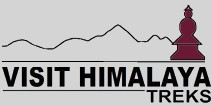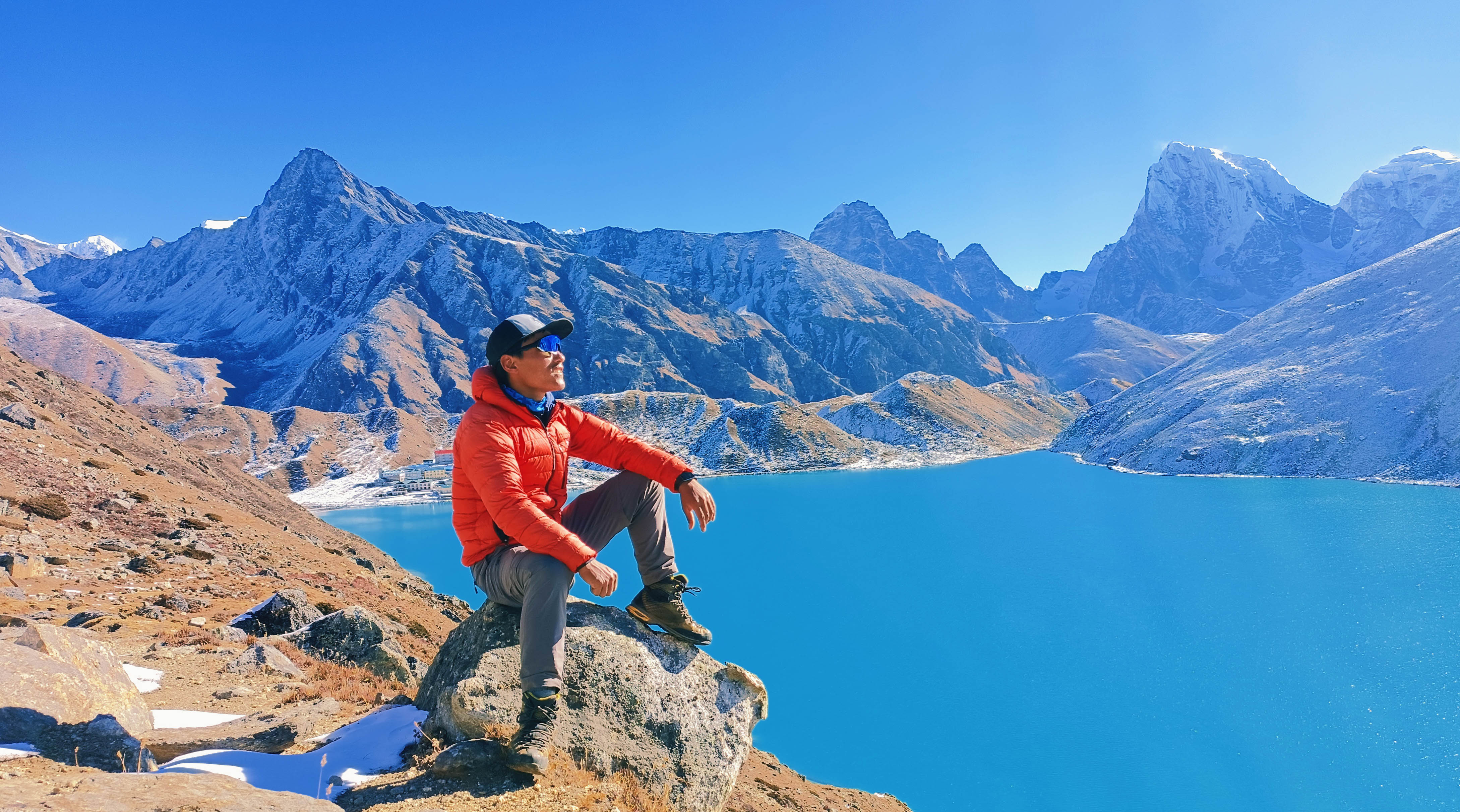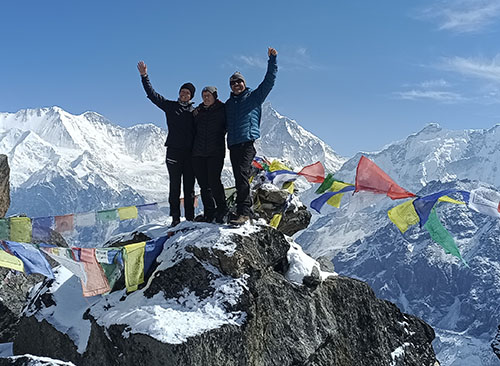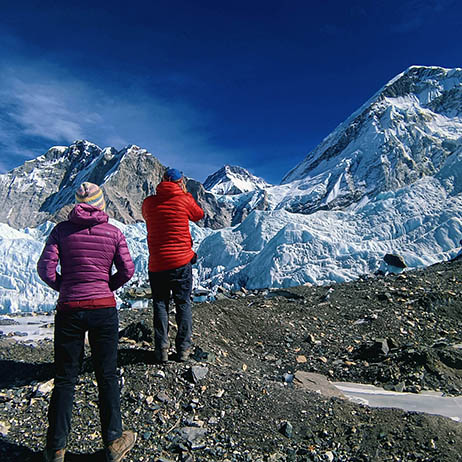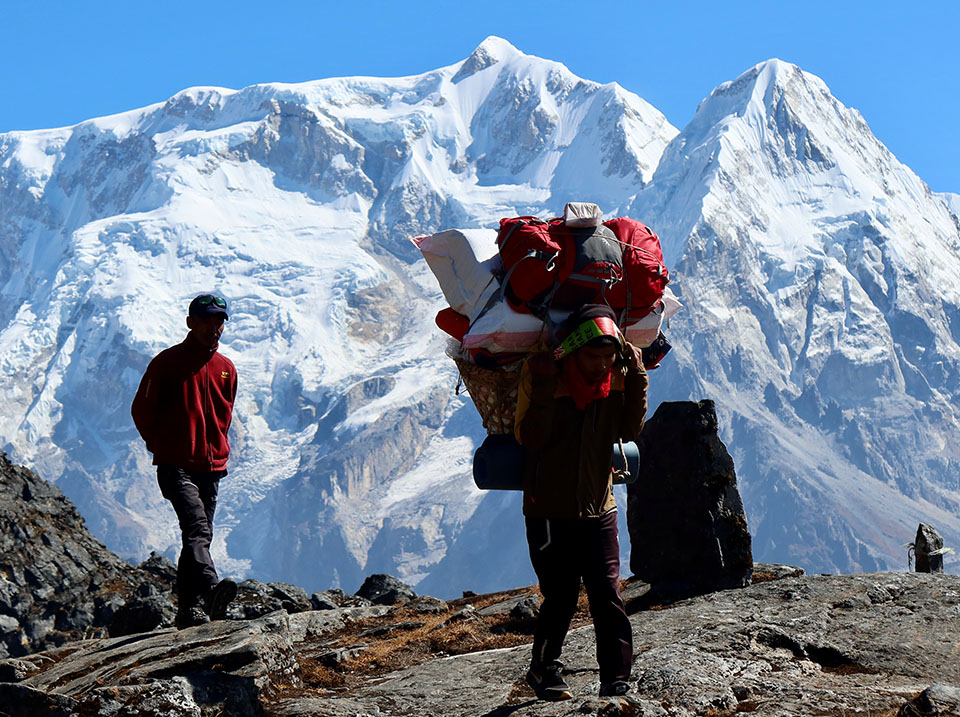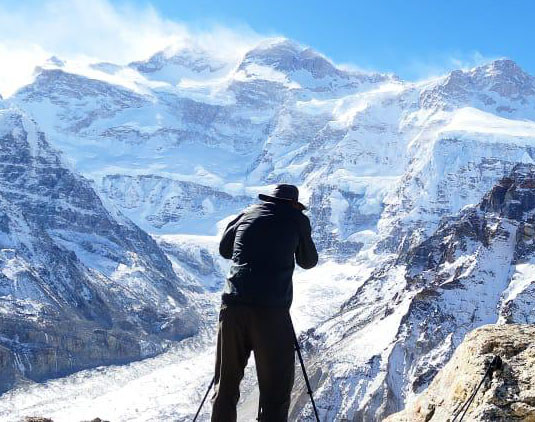Everest Three High Pass Trek is one of the toughest yet most rewarding treks in the Everest region. Designed for serious adventurers, the trek takes you deep within the Khumbu Himalayas, traversing three of the highest and most recognized mountain passes of Nepal, i.e., Kongma La (5,535 m), Cho La (5,320 m), and Renjo La (5,360 m). This trek isn't just about reaching Everest Base Camp or climbing Kala Patthar; it's about walking off the road and witnessing the full circle of the Everest region, connecting remote Sherpa villages, glacial valleys, sacred lakes, and mind-blowing scenery.
Unlike the shorter treks in Nepal that follow a simpler route, the Everest Three Pass Trek takes you around the Everest region, is immersive, and ideal for those seeking a complete Himalayan experience. You will travel across the dramatic landscapes, from deep river gorges and alpine meadows to icy glaciers and high-altitude mountain passes, all while surrounded by some of the tallest peaks in the world, including Everest, Lhotse, Nuptse, Makalu, Cho Oyu, and Ama Dablam.
It is graded as a challenging trek that includes rigorous acclimatization, but every step showers you with endless memories and cultural richness. As a photographer, an adventurer, or an experienced trekker, this trek is the perfect Everest challenge. In this blog, we break up the best 22-day Everest Three High Passes itinerary into day-by-day plans in step-by-step fashion so that you can make the most out of your trip with Visit Himalaya Treks.
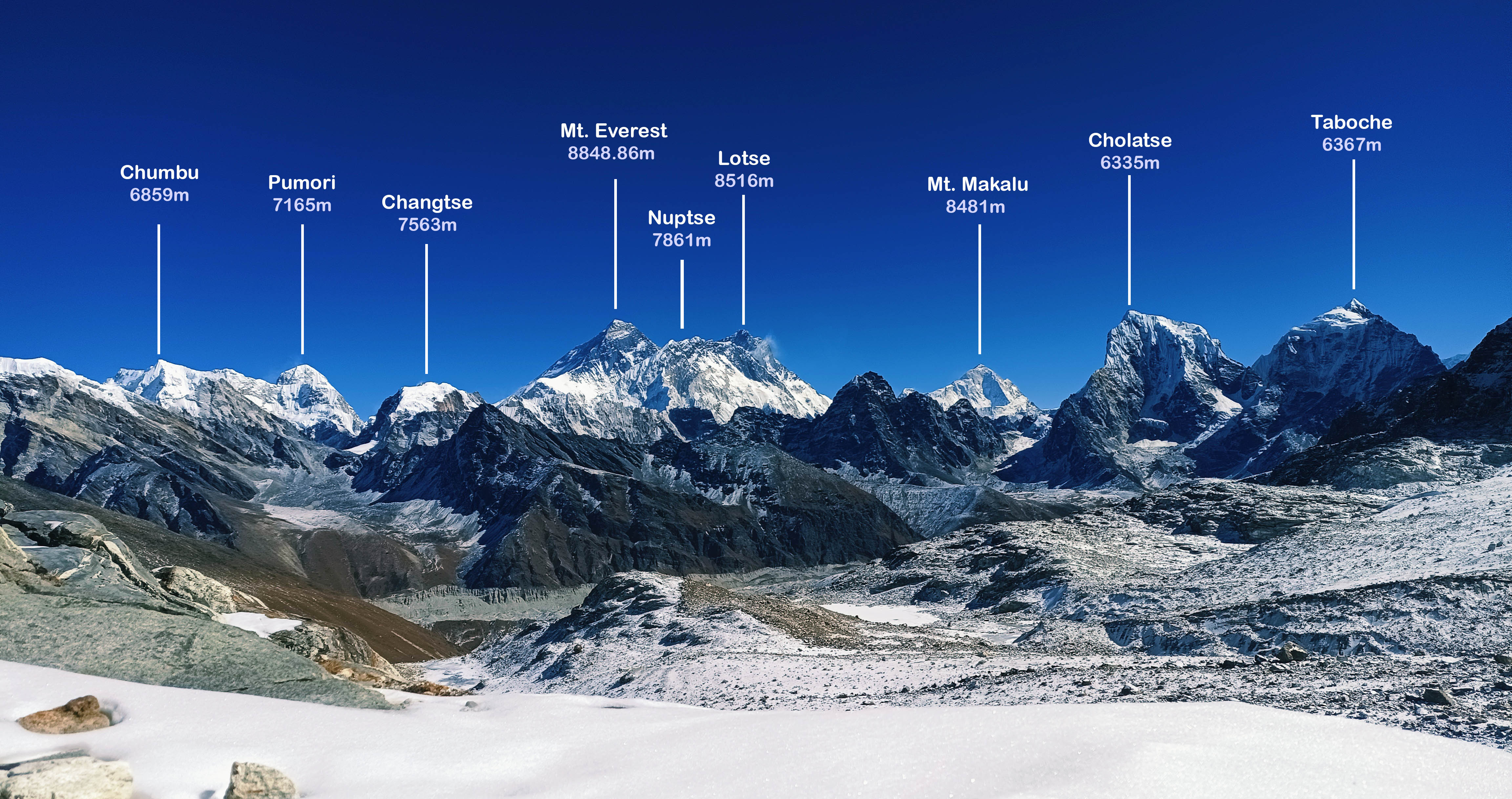
Panoramic Mountain View From Renjola Pass.
Best Time for the Everest Three High Passes Trek
Choosing the best time is the most critical aspect of organizing a successful and enjoyable Three Passes Trek. Since the trek route passes through three high-altitude passes with over 5,300 meters of altitude, favorable climate, clear weather, and stable temperatures are crucial in matters of safety as well as scenery.
Autumn is the best time of the year for the Everest Three High Passes Trek. Monsoon rain cleanses the air, providing fresh and cool air and sharp mountain views. The weather is clear, the trails are dry, and the views of Everest, Ama Dablam, and Cho Oyu are just stunning during the season. Daytime temperatures are mild, and nights are chilly, especially at high elevations. The lodges are open full-time and facilities are running at maximum.
Spring is another great time to complete the Three Passes. Trails are covered in rhododendrons and wildflowers in bloom up to approximately 4,000 meters, and there's more settled weather than in winter. That sounds good, though sometimes early morning fog in the valleys will impair morning sight. Some passes will have residual snow on them, especially in early March, but most are usually passable with the help of veteran guides.
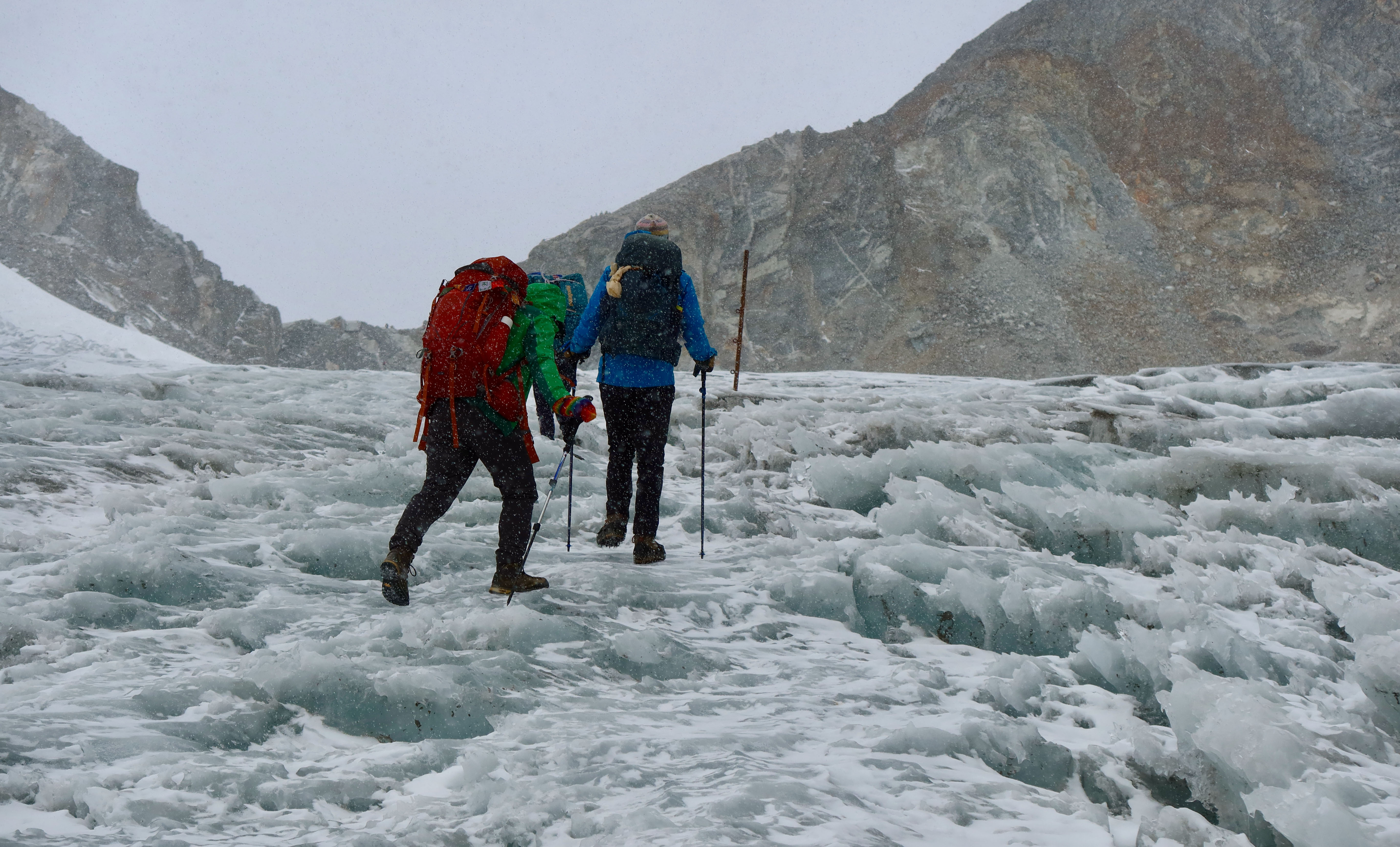
The Day on the way to Chola Pass.
Winter expeditions to the Three Passes are possible but not recommended for most trekkers. It is bitterly cold, and the high passes may be snowed in. Only seasoned and well-equipped trekkers can attempt this season. Which, naturally, leaves the trails devoid of people, and mountain scenery in winter tends to be knife-edged and otherworldly against a blue sky.
Summer is accompanied by seasonally heavy rains, lower trail landslides, slippery trails, and leech-infested trails. Clouds and mist often keep the mountains obscured from view, and flights to and from Lukla are commonly delayed. All these make summer less than the best choice of time for high-altitude treks like the Three Passes.
Highlights of the Everest Three High Passes Trek
- Cross Three Iconic High Passes, the Kongma La (5,535 m), Cho La (5,320 m), and Renjo La (5,360 m), with panoramic views of the Himalayan giants on each.
- Reach Everest Base Camp (5,364 m) and follow in the footsteps of renowned mountaineers and stand at the foot of the world's highest mountain.
- Climb Kala Patthar (5,545 m) and witness the best possible sunrise views of Mt. Everest, Lhotse, and Nuptse.
- Trek to the beautiful glacial lakes and climb Gokyo Ri for stunning Cho Oyu and Makalu views.
- Visit Tengboche and Thame Monasteries, sacred hubs of Sherpa and Himalayan Buddhism.
- Stay in traditional villages like Namche, Dingboche, and Thame, and meet the friendly and resilient Sherpa people.
- Begin and end the trek with a thrilling mountain flight to and from Lukla.
- Unlike any other treks, the Three Passes trek follows a circuit, and every day, a new path is taken.
Itinerary for the Everest Three Passes Trek
Day 1: Arrival in Kathmandu (1,335 meters)
You'll arrive at Tribhuvan International Airport in Kathmandu, the lively capital city of Nepal. Our representatives will meet you with a warm welcome and take you to your hotel. You can spend the day relaxing, and preparing for your upcoming adventure. In the evening, have an orientation session with your trekking guide on the itinerary, gear, and safety protocols.
Day 2: Fly to Lukla (2,840 meters) and hike to Phakding (2,610 meters) ↑1490m ↓ 230m
For Kathmandu – Lukla flight: Wake up around 5 to 6 am and drive to the domestic airport in Kathmandu for about 30 minutes and fly to Lukla (35 minutes). Applicable for the remaining months, except peak trekking months.
For Manthali – Lukla flight: Wake up around 2:30 am, drive to Manthali by Car, Jeep, Hice for about 4 to 5 hours, and fly to Lukla (20 minutes). Applicable for the peak trekking months of March, April, May, October, and November.
An early morning scenic flight to Lukla (35 minutes) is followed by a leisurely breakfast at Lukla. We meet up with our crew and after a brief introduction and a quick sorting of our daypack and the main bags, our adventure starts. The trail gradually drops into the Dudh Koshi Valley and passes through the lovely Sherpa villages of Chauri Kharka, Cheplung, then undulates through villages of Thado Koshi, Ghat, and finally arrives at Phakding.
First views of Kusum Kanguru (6367 meters) can be viewed at Thado Koshi just before a small climb at Thado Koshi. During the day and in most of the other days on the trek, we follow the Dudh Koshi river and pass through couple of suspension bridges and several mani walls, mani stone, chorten, stupas and prayer flags with snowcapped mountains in the background. (3 hours)
Trekking time: 3–4 hours
Highlights: Scenic flight, first glimpse of Khumbu scenery, river trekking
Day 3: Trek to Namche Bazaar (3,440 meters) ↑925m↓95m
Today's trek is more challenging, as you ascend gradually to Namche Bazaar, the vibrant Sherpa town and gateway to Everest. The trail rises in altitude through forest, villages, and gorgeous views of mountains like Thamserku and Kusum Kanguru. You will pass over the iconic suspension bridge over the Dudh Koshi River and reach Namche Bazaar in the afternoon. A good place to look for local shops, cafes, and Sherpa culture.
Trekking time: 6–7 hours
Highlights: Stunning panoramas of Thamserku and Everest, vibrant Sherpa village, entrance to the park
Day 4: Acclimatization Day at Namche Bazaar ↑↓360m
We spend today acclimatizing your body to the high altitude. You may walk along nearby trails, visit the Sherpa Museum, or hike up to the Everest View Hotel for breathtaking views of Everest, Lhotse, and Ama Dablam. Your guide will also brief you on the signs of altitude sickness and safety protocols.
Activity: Easy hiking (approx. 2–3 hours)
Highlights: Everest scenery, cultural discovery, adequate rest for acclimatization
Day 5: Trek to Tengboche (3,860 meters) ↑610m ↓190m
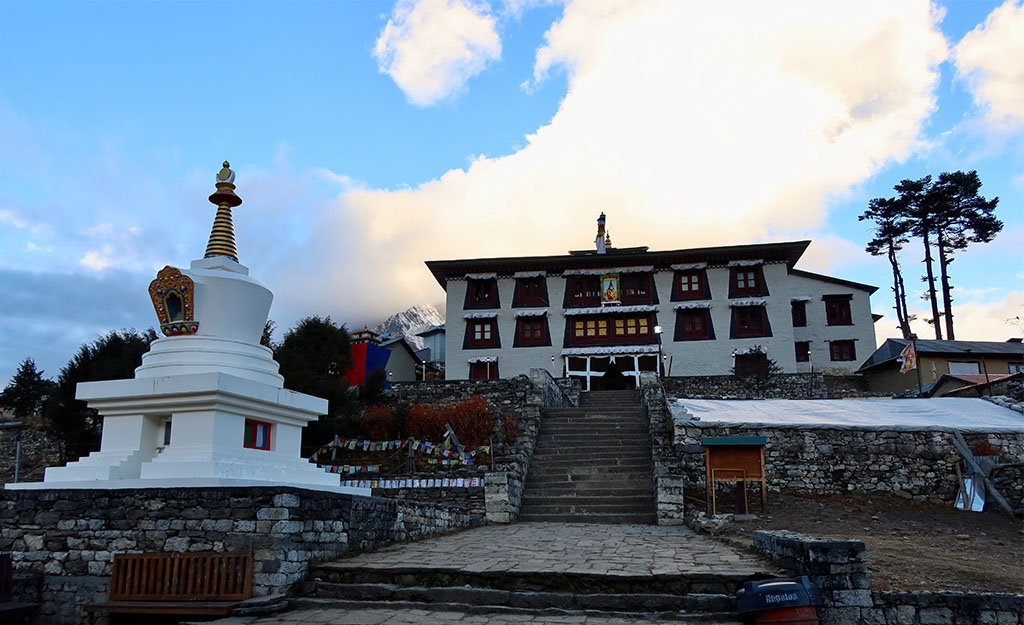
Tengboche Monastery on the way to the Everest Three High Pass.
You'll trek via pine forests and along small villages to arrive at Tengboche, famous for its ancient Buddhist monastery. This tranquil spot has a view of Everest, Lhotse, and Ama Dablam. You learn about Sherpa spirituality and culture when you visit Tengboche Monastery.
Trekking time: 5–6 hours
Highlights: Rhododendron forests, Buddhist chanting in the monastery, sweeping mountain views
Day 6: Trek to Dingboche (4410 meters) ↑660m ↓110m
The path now traverses breathtaking rhododendron forests and old Sherpa villages before reaching Dingboche, which is nestled in a sunny valley. At over 4,200 meters, Dingboche is another acclimatization site of significance. The landscape here shifts to a more alpine landscape with spectacular views of Ama Dablam and Lhotse.
Trekking time: 6 hours
Highlights: Imja Valley, view of Island Peak and Ama Dablam, fields enclosed by stone walls
Day 7: Trek to Chukung (4,730 meters) ↑520m
Your trek advances to Chukung, a small village which is situated below gigantic mountains. Chukung is a perfect spot for acclimatization walks and offers stunning views of the surrounding mountains. It's less busy and less touristy than other villages and has a peaceful environment for rest.
Trekking time: 3–4 hours
Highlights: Panoramic views of the valley at high altitude, glacial rivers, peaceful trails
Day 8: Acclimatization Day at Chukung
This is a rest and acclimatization day. You can climb to nearby viewpoints like Chukung Ri (about 5,500 meters) to enjoy marvelous views of Island Peak, Lhotse, and Makalu. This day acclimatizes your body for the upcoming higher passes.
Activity: Half-day hike to Chhukung Ri
Highlights: Optimal acclimatization for Kongma La, spectacular mountain scenery
Day 9: Cross Kongma La Pass (5,535 meters) and Trek to Lobuche (4,910 meters) ↑805m↓625m
One of the most challenging days, ascending over the Kongma La Pass, the highest of the three passes of the trek. The ascent is very steep and requires good stamina and slow moving. On descending from the pass, you descend to the Lobuche settlement, a tiny trekking village set in spectacular mountain landscapes.
Trekking time: 7–8 hours
Highlights: Glacier treks, stunning summit views, sense of achievement
Day 10: Trek to Gorakshep (5,140 meters) ↑230m
The trail from Lobuche to Gorakshep traverses rocky and glacial terrain. Gorakshep is a basic settlement and the last stop before Everest Base Camp. The altitude here is high, so pace yourself and stay hydrated. You’ll rest here and prepare for the next day’s early climb.
Trekking time: 3–4 hours
Highlights: Trek on glacial moraine, close to Everest Base Camp
Day 11: Climb Kala Patthar (5,550 meters) and Return to Lobuche (4,910 meters) ↑410m↓640m
Kala Patthar is famous for its spectacular close-up views of Everest’s summit, especially at sunrise. The climb is steep but rewarding, offering one of the best vantage points in the region. After enjoying the views and photography, you’ll descend back to Lobuche to rest.
Trekking time: 6–7 hours
Highlights: Sunrise on Everest, 360° panorama of Himalayan giants
Day 12: Dzongla Trek (4,830 meters) ↓80m
You depart Lobuche and hike along a dirty track to Dzongla, traversing moraine and glacial rocks. Dzongla is a small village with simple teahouse lodging and is a necessary stop before the next high pass. Views are stunning with massive peaks and frozen glaciers in the distance, psyching you up and preparing you physically for the challenges that lie ahead.
Trekking time: 2–3 hours
Highlights: Birds Eye Views of Chola- Tsho a Glacial Lake.
Day 13: Cross Cho La Pass (5,420 meters) and Trek to Dragnag (4,700 meters) ↑590m↓720m
You encounter the second of the three passes, the Cho La Pass, today. The climb is steep and could be icy or snowy in winter, so you may want to prepare for rugged footing. Once you cross the pass, you track into the Gokyo Valley to arrive at Dragnag village. It is not as congested as the Everest Base Camp trail, with lovely lakes and no-holds-barred mountain views surrounding you.
Trekking time: 7–8 hours
Highlights: Glacier treks, stunning summit views, sense of achievement.
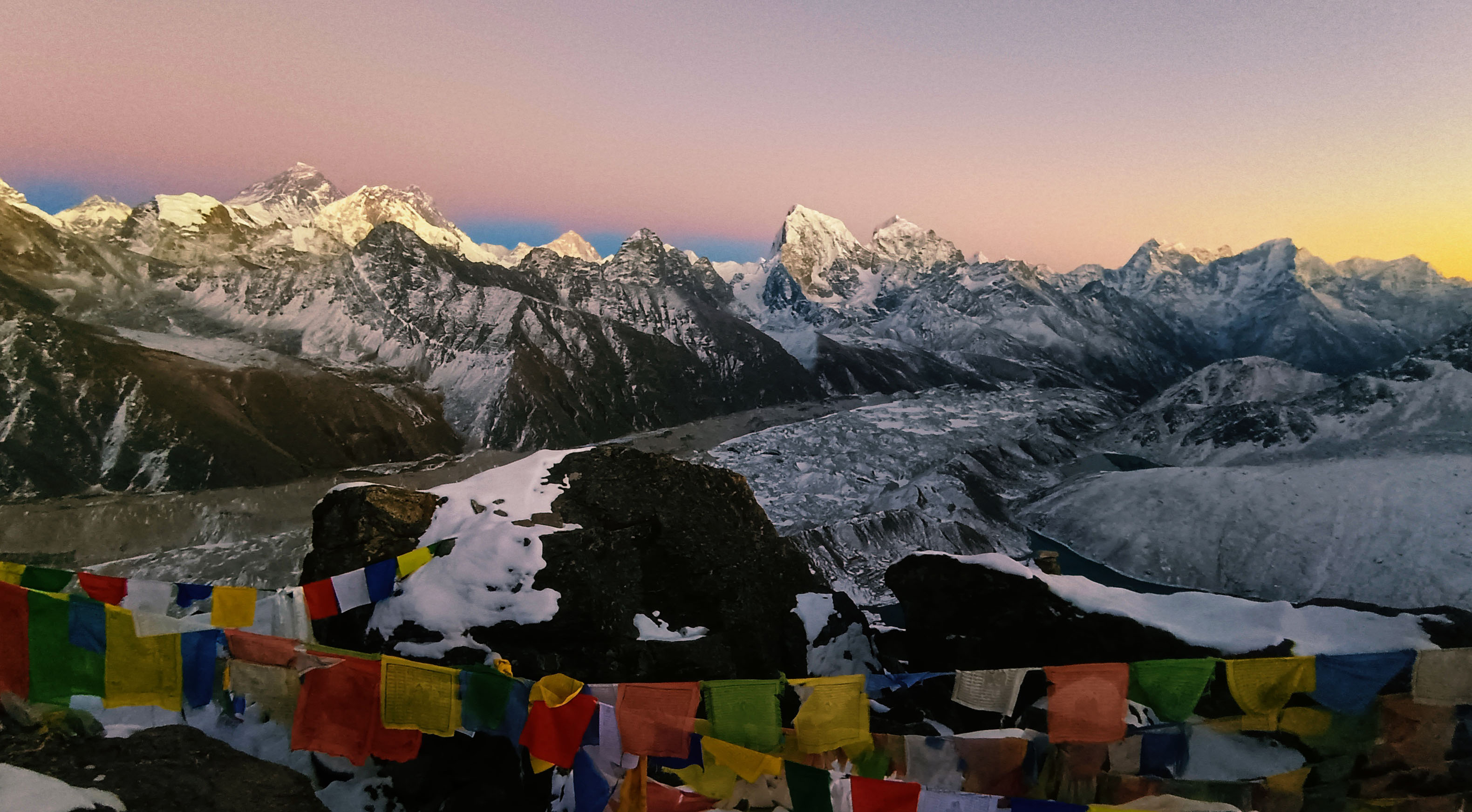
Amazing Mountain Views from Gokyo-Ri.
Day 14: Trek to Gokyo (4,790 meters) ↑90m
The short, relatively easy trek of the day takes you to the village of Gokyo, which runs along the turquoise waters of Gokyo Lakes. Gokyo is famous for its beauty and peaceful surroundings. Gokyo offers another view of Everest and the surrounding peaks, untainted by the tourist throngs of Everest Base Camp.
Trekking time: 3–4 hours
Highlights: Glacier treks, Crystal Clear Gokyo Lake view.
Day 15: Acclimatization Day at Gokyo
Spend today acclimatizing and exploring. You can hike to Gokyo Ri (5,357 meters), a challenging ascent with spectacular views of Everest, Lhotse, Makalu, and Cho Oyu. The peaceful lake reflections and expansive mountain scenery make it a photographer's heaven.
Activity: Half-day hike to Gokyo Ri
Highlights: Sunrise on the Everest and other Peaks, 360° spectacular mountain scenery
Day 16: Cross Renjo La Pass (5,360 meters) and Trek to Lungdhen (4,368 meters) ↑570m↓992m
The third and final high pass is the Renjo La. The pass offers breathtaking views over the western flank of the Everest range. You head down to Lungdhen after passing through, a peaceful village where you rest and prepare for the final section of the trek.
Trekking time: 7–8 hours
Highlights: Glacier treks, stunning summit views, a sense of achievement enjoy the Last Pass of the Trek.
Day 17: Trek to Thame (3,820 meters) ↓548m
The trail winds down through pine forest and terraced fields to Thame, a Sherpa cultural and historic village. It was the home village of Tenzing Norgay, the first person to climb Everest, and you may spot nearby monasteries and greet Sherpa families.
Trekking time: 5–6 hours
Highlights: Sherpa Tradition, the home village of Tenzing Norgay Sherpa, the first person to Summit Mt. Everest.
Day 18: Trek to Monjo (2,835 meters) ↑145m↓1130m
Today, you still drop down through the rhododendron forest and villages. Monjo is at the entrance to Sagarmatha National Park and offers fair teahouse accommodation. It is here that most trekkers reach the finish of the Everest Base Camp circuit.
Trekking time: 5–6 hours
Highlights: Walk Pass The Sherpa Town Namche Bazaar, Exit Sagarmatha National Park.
Day 19: Trek to Lukla (2,810 meters) ↑350↓345
The final day of trekking brings you back to Lukla, the place where your Everest adventure started. Celebrate the end of this challenging trek with your team and enjoy the final night in a good lodge.
Trekking time: 5–6 hours
Highlights: The Final Strength of the Treks, The last Celebration of the Trip is over.
Day 20: Fly back to Kathmandu (1,350 meters)
Fly back to Kathmandu from Lukla early in the morning. The flight has excellent scenery of the Himalaya mountains from high altitude. Transfer to the hotel upon arrival and spend the day resting in the capital.
Flight time: 30-40 Minutes
Highlights: Enjoy the Scenic view from the Small Windows
Day 21: Free day in Kathmandu
Use the day to relax, see the city's cultural attractions, shop for souvenirs, or just indulge in a comfortable hotel. This is your chance to reflect back on your incredible trekking adventure and experience the Kathmandu night life.
Activities time: as per your interests
Highlights: Explore the cultural heritage of Kathmandu City and last-Minute shopping.
Day 22: Departure
You will be transferred to Tribhuvan International Airport for the departure flight. Bring with your memories of a lifetime of the Everest area and the excitement of conquering the Three High Passes.
Frequently Asked Questions (FAQs) about the Everest Three High Passes Trek
1. What are the Three High Passes of this trek?
The three high passes are:
- Kongma La Pass (5,535 m)
- Cho La Pass (5,320 m)
- Renjo La Pass (5,360 m)
These three passes connect different valleys of the Khumbu region and offer some of the best panoramic views of the Himalayas.
2. How tough is the Everest Three Passes Trek?
This trek is highly strenuous due to high altitude, crossing passes, and the time taken. It's advisable to only experienced trekkers or people with good physical fitness who have a history of trekking in high altitudes or with a strong mental setup.
3. Do I need previous trekking experience?
Yes, recommended previous experience in trekking at high altitudes above 4,000 meters. However, physically fit rookies with the right determination and acclimatization can also complete this trek.
4. What is the best time for the Three Passes Trek?
The ideal times are:
- Spring (March to May)
- Fall (Mid-September to November)
These times have clear skies, consistent weather, and spectacular mountain scenery. Winter is simply too cold and snowy, and monsoon trails are cloudy and slippery.
5. How long does the trek take?
The standard itinerary takes around 18 to 22 days based on acclimatization days, side trips (e.g., EBC or Gokyo Ri), and weather conditions.
6. Can I do the Three Passes Trek independently?
Yes, you can do this trek solo, but it is not recommended due to isolated trails, unpredictable weather, and potential altitude sickness. A guide enhances your safety, especially while going over passes.
7. What kind of permits will I need?
You will need:
The Sagarmatha National Park entry permits can be organized in Kathmandu or during the trek. But Khumbu Pasang Lhamu Rural Municipality Entry Permits can only be obtained in Lukla.
8. Is Acute Mountain Sickness (AMS) a risk on this trek?
Yes, high risk of AMS because there are several high passes and very high altitudes. Proper acclimatization, hydration with lots of water, and slow walking are the key steps to prevent AMS.
9. What kind of accommodation can I expect?
Mountain lodges or teahouses line the trek. They offer basic rooms, typically twin-bedded, shared toilets, and communal dining areas. Facilities become more basic and more expensive the higher up you go.
10. Is Wi-Fi or charging available?
Wi-Fi is available in most villages (sometimes on a paying basis), but can be sluggish or intermittent. Charging stations are also available in most teahouses, sometimes at an additional charge. A power bank and a local SIM card (e.g., Ncell or NTC) are helpful.
11. What are the food options along the trek?
You can have a variety of meals, including Dal Bhat, fried rice, pasta, noodles, momos, porridge, eggs, and soup. The menu is very typical throughout the region. Vegetarian food should be adhered to as much as possible to steer clear of stomach issues.
12. How cold is it on the passes?
Temperatures will dip in the range of -10°C to -20°C during early mornings and evenings, especially at higher elevations and during shoulder seasons. Layering clothes and a decent sleeping bag (-15°C or lower) are essentials.
13. Will I see Everest on this trek?
Yes! You see Mount Everest several times, especially from Kala Patthar, Gokyo Ri, Renjo La Pass, and Cho La Pass, focusing on some of the best-ever Everest panorama pictures.
14. Are banking services or ATMs accessible along the trail?
Namche Bazaar has ATMs, but these do not always work. It is a good idea to exchange enough Nepali rupees (NPR) in Kathmandu for use on the trail.
15. What is done in case of an emergency?
If you develop altitude sickness or injuries, your guide will arrange for emergency evacuation (most probably by helicopter). Travel insurance with coverage for high-altitude trekking and helicopter evacuation is mandatory.
